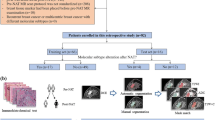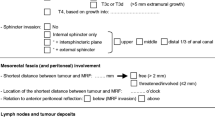Abstract
Objectives
To test whether a 4-fold accelerated 3D T2-weighted (T2) CAIPIRINHA SPACE TSE sequence with isotropic voxel size is equivalent to conventional 2DT2 TSE for the evaluation of intrinsic and perilesional soft tissue tumors (STT) characteristics.
Methods
For 108 patients with histologically-proven STTs, MRI, including 3DT2 (CAIPIRINHA SPACE TSE) and 2DT2 (TSE) sequences, was performed. Two radiologists evaluated each sequence for quality (diagnostic, non-diagnostic), tumor characteristics (heterogeneity, signal intensity, margin), and the presence or absence of cortical involvement, marrow edema, and perilesional edema (PLE); tumor size and PLE extent were measured. Signal-to-noise (SNR) and contrast-to-noise (CNR) ratios and acquisition times for 2DT2 in two planes and 3DT2 sequences were reported. Descriptive statistics and inter-method agreement were reported.
Results
Image quality was diagnostic for all sequences (100% [108/108]). No difference was observed between 3DT2 and 2DT2 tumor characteristics (p < 0.05). There was no difference in mean tumor size (3DT2: 2.9 ± 2.5 cm, 2DT2: 2.8 ± 2.6 cm, p = 0.4) or PLE extent (3DT2:0.5 ± 1.2 cm, 2DT2:0.5 ± 1.0 cm, p = 0.9) between the sequences. There was no difference in the SNR of tumors, marrow, and fat between the sequences, whereas the SNR of muscle was higher (p < 0.05) on 3DT2 than 2DT2. CNR measures on 3DT2 were similar to 2DT2 (p > 0.1). The average acquisition time was shorter for 3DT2 compared with 2DT2 (343 ± 127 s vs 475 ± 162 s, respectively).
Conclusion
Isotropic 3DT2 MRI offers higher spatial resolution, faster acquisition times, and equivalent assessments of STT characteristics compared to conventional 2DT2 MRI in two planes. 3DT2 is interchangeable with a 2DT2 sequence in tumor protocols.
Key Points
• Isotropic 3DT2 CAIPIRINHA SPACE TSE offers higher spatial resolution than 2DT2 TSE and is equivalent to 2DT2 TSE for assessments of soft tissue tumor intrinsic and perilesional characteristics.
• Multiplanar reformats of 3DT2 CAIPIRINHA SPACE TSE can substitute for 2DT2 TSE acquired in multiple planes, thereby reducing the acquisition time of MRI tumor protocols.
• 3DT2 CAIPIRINHA SPACE TSE and 2DT2 TSE had similar CNR of tissues.





Similar content being viewed by others
Abbreviations
- 2D:
-
Two dimensional
- 3D:
-
Three dimensional
- ADC:
-
Apparent diffusion coefficient
- CAIPIRINHA:
-
Controlled Aliasing in Parallel Imaging Results in Higher Acceleration
- CNR:
-
Contrast-to-noise ratio
- DWI:
-
Diffusion-weighted MR imaging
- FOV:
-
Field-of-view
- FSE:
-
Fast spin-echo
- IW:
-
Intermediate weighted
- MRI:
-
Magnetic resonance imaging
- PACS:
-
Picture archiving and communication system
- ROI:
-
Region of interest
- SI:
-
Signal intensity
- SNR:
-
Signal-to-noise ratio
- SPACE:
-
Sampling perfection with application-optimized contrasts using different flip angle evolution
- SPAIR:
-
Spectral adiabatic inversion-recovery
- SPIR:
-
Spectral presaturation with inversion recovery
- TE:
-
Echo time
- TR:
-
Repetition time
- TSE:
-
Turbo spin echo
- TWIST:
-
Time-resolved angiography with interleaved stochastic trajectories
- VIBE:
-
Volume intercalated breathold exam
- W:
-
Weighted
References
Altahawi FF, Blount KJ, Morley NP, Raithel E, Omar IM (2017) Comparing an accelerated 3D fast spin-echo sequence (CS-SPACE) for knee 3-T magnetic resonance imaging with traditional 3D fast spin-echo (SPACE) and routine 2D sequences. Skeletal Radiol 46:7–15
Chan WP, Lang P, Chieng PU, Davison PA, Huang SC, Genant HK (1991) Three-dimensional imaging of the musculoskeletal system: an overview. J Formos Med Assoc 90:713–722
Del Grande F, Delcogliano M, Guglielmi R et al (2018) Fully automated 10-minute 3D CAIPIRINHA SPACE TSE MRI of the knee in adults: a multicenter, multireader, multifield-strength validation study. Invest Radiol 53:689–697
Del Grande F, Guggenberger R, Fritz J (2021) Rapid musculoskeletal MRI in 2021: value and optimized use of widely accessible techniques. AJR Am J Roentgenol 216:704–717
Fayad LM, Parekh VS, de Castro Luna R et al (2020) A deep learning system for synthetic knee magnetic resonance imaging: is artificial intelligence-based fat-suppressed imaging feasible? Invest Radiol 56(6):357–368
Fritz B, Bensler S, Thawait GK, Raithel E, Stern SE, Fritz J (2019) CAIPIRINHA-accelerated 10-min 3D TSE MRI of the ankle for the diagnosis of painful ankle conditions: performance evaluation in 70 patients. Eur Radiol 29:609–619
Fritz J, Ahlawat S, Fritz B et al (2019) 10-Min 3D turbo spin echo MRI of the knee in children: arthroscopy-validated accuracy for the diagnosis of internal derangement. J Magn Reson Imaging 49:e139–e151
Fritz J, Fritz B, Zhang J et al (2017) Simultaneous multislice accelerated turbo spin echo magnetic resonance imaging: comparison and combination with in-plane parallel imaging acceleration for high-resolution magnetic resonance imaging of the knee. Invest Radiol 52:529–537
Fritz J, Raithel E, Thawait GK, Gilson W, Papp DF (2016) Six-fold acceleration of high-spatial resolution 3D SPACE MRI of the knee through incoherent k-space undersampling and iterative reconstruction-first experience. Invest Radiol 51:400–409
Glaser C, D'Anastasi M, Theisen D et al (2015) Understanding 3D TSE sequences: advantages, disadvantages, and application in MSK imaging. Semin Musculoskelet Radiol 19:321–327
Kalia V, Fritz B, Johnson R, Gilson WD, Raithel E, Fritz J (2017) CAIPIRINHA accelerated SPACE enables 10-min isotropic 3D TSE MRI of the ankle for optimized visualization of curved and oblique ligaments and tendons. Eur Radiol 27:3652–3661
Ristow O, Steinbach L, Sabo G et al (2009) Isotropic 3D fast spin-echo imaging versus standard 2D imaging at 3.0 T of the knee--image quality and diagnostic performance. Eur Radiol 19:1263–1272
Shakoor D, Guermazi A, Kijowski R et al (2018) Diagnostic performance of three-dimensional MRI for depicting cartilage defects in the knee: a meta-analysis. Radiology 289:71–82
Shakoor D, Guermazi A, Kijowski R et al (2019) Cruciate ligament injuries of the knee: a meta-analysis of the diagnostic performance of 3D MRI. J Magn Reson Imaging 50:1545–1560
Klyce W, Fritz J, Ahlawat S, Thawait G, Raithel E, Lee RJ (2019) 10-minute 3D MRI in children with acute knee trauma: Arthroscopy-Based Diagnostic Accuracy For The Diagnosis Of Internal Derangement. Orthop J Sports Med 7:2325967119S2325900133
Luna R, Fritz J, Del Grande F, Ahlawat S, Fayad LM (2020) Determination of skeletal tumor extent: is an isotropic T1-weighted 3D sequence adequate? Eur Radiol. https://doi.org/10.1007/s00330-020-07394-4
Breuer FA, Blaimer M, Heidemann RM, Mueller MF, Griswold MA, Jakob PM (2005) Controlled aliasing in parallel imaging results in higher acceleration (CAIPIRINHA) for multi-slice imaging. Magn Reson Med 53:684–691
Zhai H, Lv Y, Kong X, Liu X, Liu D (2019) Magnetic resonance neurography appearance and diagnostic evaluation of peripheral nerve sheath tumors. Sci Rep 9:6939
Hossein J, Fariborz F, Mehrnaz R, Babak R (2019) Evaluation of diagnostic value and T2-weighted three-dimensional isotropic turbo spin-echo (3D-SPACE) image quality in comparison with T2-weighted two-dimensional turbo spin-echo (2D-TSE) sequences in lumbar spine MR imaging. Eur J Radiol Open 6:36–41
Lee S, Jee WH, Jung JY, Lee SY, Ryu KS, Ha KY (2015) MRI of the lumbar spine: comparison of 3D isotropic turbo spin-echo SPACE sequence versus conventional 2D sequences at 3.0 T. Acta Radiol 56:174–181
Zhao F, Ahlawat S, Farahani SJ et al (2014) Can MR imaging be used to predict tumor grade in soft-tissue sarcoma? Radiology 272:192–201
Ahlawat S, Morris C, Fayad LM (2016) Three-dimensional volumetric MRI with isotropic resolution: improved speed of acquisition, spatial resolution and assessment of lesion conspicuity in patients with recurrent soft tissue sarcoma. Skeletal Radiol 45:645–652
Fayad LM, Jacobs MA, Wang X, Carrino JA, Bluemke DA (2012) Musculoskeletal tumors: how to use anatomic, functional, and metabolic MR techniques. Radiology 265:340–356
Jung JY, Yoon YC, Kim HR, Choe BK, Wang JH, Jung JY (2013) Knee derangements: comparison of isotropic 3D fast spin-echo, isotropic 3D balanced fast field-echo, and conventional 2D fast spin-echo MR imaging. Radiology 268:802–813
Kijowski R, Davis KW, Woods MA et al (2009) Knee joint: comprehensive assessment with 3D isotropic resolution fast spin-echo MR imaging--diagnostic performance compared with that of conventional MR imaging at 3.0 T. Radiology 252:486–495
Yoon MA, Hong SJ, Lee KC, Lee CH (2019) Contrast-enhanced magnetic resonance imaging of pelvic bone metastases at 3.0 T: comparison between 3-dimensional t1-weighted CAIPIRINHA-VIBE sequence and 2-dimensional T1-weighted turbo spin-echo sequence. J Comput Assist Tomogr 43:46–50
Elias DA, White LM, Simpson DJ et al (2003) Osseous invasion by soft-tissue sarcoma: assessment with MR imaging. Radiology 229:145–152
Holzapfel K, Regler J, Baum T et al (2015) Local staging of soft-tissue sarcoma: emphasis on assessment of neurovascular encasement-value of MR imaging in 174 confirmed cases. Radiology 275:501–509
Reeder SB, Wintersperger BJ, Dietrich O et al (2005) Practical approaches to the evaluation of signal-to-noise ratio performance with parallel imaging: application with cardiac imaging and a 32-channel cardiac coil. Magn Reson Med 54:748–754
Wolff SD, Balaban RS (1997) Assessing contrast on MR images. Radiology 202:25–29
Landis JR, Koch GG (1977) The measurement of observer agreement for categorical data. Biometrics 33:159–174
Belloni E, Tentoni S, Puci MV et al (2020) Patient perception of musculoskeletal MR: a survey research. Curr Med Imaging 16:1154–1160
Crombé A, Marcellin PJ, Buy X et al (2019) Soft-tissue sarcomas: assessment of MRI features correlating with histologic grade and patient outcome. Radiology 291:710–721
Del Grande F, Santini F, Herzka DA et al (2014) Fat-suppression techniques for 3-T MR imaging of the musculoskeletal system. Radiographics 34:217–233
Kirchgesner T, Perlepe V, Michoux N, Larbi A, Vande Berg B (2018) Fat suppression at three-dimensional T1-weighted MR imaging of the hands: Dixon method versus CHESS technique. Diagn Interv Imaging 99:23–28
Funding
The authors state that this work has not received any funding.
Author information
Authors and Affiliations
Corresponding author
Ethics declarations
Guarantor
The scientific guarantor of this publication is Laura Fayad.
Conflict of interest
The authors of this manuscript declare relationships with the following companies: SIEMENS AG.
Statistics and biometry
No complex statistical methods were necessary for this paper.
Informed consent
Written informed consent was waived by the Institutional Review Board.
Ethical approval
Institutional Review Board approval was obtained.
Methodology
-
retrospective
-
observational
-
performed at one institution
Additional information
Publisher’s note
Springer Nature remains neutral with regard to jurisdictional claims in published maps and institutional affiliations.
Rights and permissions
About this article
Cite this article
de Castro Luna, R., Kumar, N.M., Fritz, J. et al. MRI evaluation of soft tissue tumors: comparison of a fast, isotropic, 3D T2-weighted fat-saturated sequence with a conventional 2D T2-weighted fat-saturated sequence for tumor characteristics, resolution, and acquisition time. Eur Radiol 32, 8670–8680 (2022). https://doi.org/10.1007/s00330-022-08937-7
Received:
Revised:
Accepted:
Published:
Issue Date:
DOI: https://doi.org/10.1007/s00330-022-08937-7




